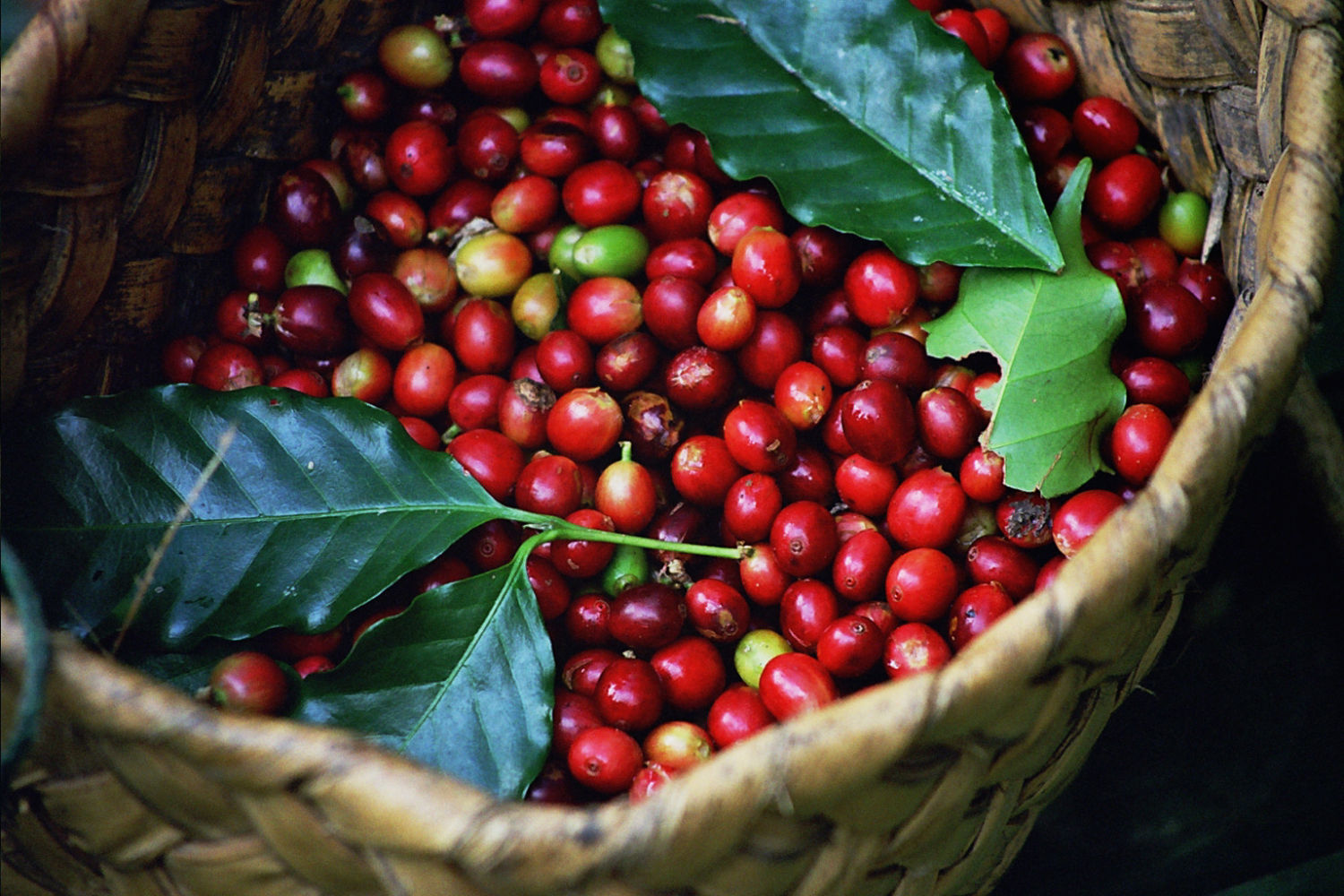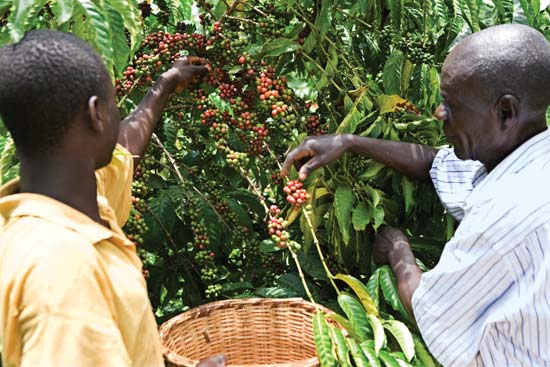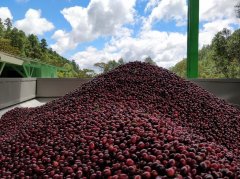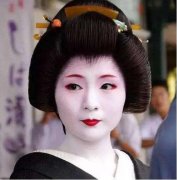Uganda Coffee Flavor Taste Features History Arabica Robusta Coffee Bean Region
Uganda is one of the major producers of Robusta coffee beans. Some Arabica coffee also grows in different highlands of the country, most notably the slopes of Mount Elgon and Mount Ruwenzori, which borders Kenya. Mount Ruwenzori is commonly known as the "Mountain of the Moon" where it borders Kenya. Some Arabica coffee is also grown in the West Nile region in the northwest of the country.
Although the overall economy has expanded and improved in recent years, coffee remains crucial, with average income accounting for less than 60 per cent of annual export earnings between 1996 and 2000. It is estimated that up to 20% of the entire population derives all or most of its cash income from coffee.
After decades of full state control of the industry, the coffee industry was fully liberalized between 1991 and 1992 and is now entirely privately controlled. However, export quality control remains the responsibility of the Uganda Coffee Development Authority (UCDA), which is responsible for grading, alcohol and classification of all exports.

In the six years from 1996 to 2001, the average production was close to 3.3 million bags, with a peak of 4.2 million bags in 1996 (the last occurred in 1972) and a low of 2 million bags in 2005. The proportion of Arabica coffee fluctuates between 8% and 10% of the total. Local consumption accounts for only about 3% of output.
Most of the coffee grown in Uganda (80 per cent) is Coffea canephora var.robusta, while the other 20 per cent includes Arabica varieties Typica, SL 14, SL 28 and Kent. The Arabica variety Bugishu/Bugisu (Coffea arabica var. Bugishu), which grows on Mt. Near Sipi Falls on the west side of the mountain. Elgon, one of the largest mountains in Uganda.
Generally speaking, coffee cultivation is divided into:
West Nile (Ocolo-northwest bordering the Democratic Republic of the Congo and Sudan)
Northern region (lira, Gulu)
East (Mbalai, Bujisu-bordering Kenya)
Central and southwestern (Jinja, Mukono, Kampala, Masaka-Lake Victoria)
The western region (Kasese, Mbalala-also bordering the Democratic Republic of the Congo)
Although Arabica coffee was introduced in the early 1900s, Robusta coffee is the country's native coffee and has been a part of Ugandan life for centuries. A variety of wild robusta coffee still grows in the Ugandan rainforest today and is considered one of the rarest natural coffee trees in the world.

Most Robusta are sun-dried, although some attempts have been made in recent years to reintroduce wet processing. With the support of UCDA, these interventions continue today. In the early 1960s, the Ugandan coffee industry produced nearly 25000 tons of high-quality pulped and washed robusta coffee, but in the monopoly era, this part completely disappeared, along with the farming industry that supported it. It is estimated that today there are about 500000 small farms of different sizes growing at least some coffee.
Originally from Uganda, Robusta grows two types, namely "Nganda" and "Erecta". Extensive clone replantation programs combine high-yielding clones of two asexual and self-sterile varieties. Offspring are true types and retain their parental characteristics-they produce higher yields, mature faster, produce larger beans, and improve the characteristics of the liquor. They also tend to show resistance to coffee leaf rust.
The inherent quality of Ugandan robusta coffee beans has been excellent, and ongoing replanting programmes using this locally developed clonal material may lead to a general restoration of the country's ability to supply quality, neutral coffee. Ugandan robusta coffee grows at relatively high altitudes, some as high as 1500 metres, which makes these coffees particularly attractive to the fast-growing espresso industry. However, most Robusta is used to produce instant coffee and as a cheap filler for mixtures. Most Arabica coffee is processed by manual pulping machines. However, attempts are being made to upgrade the process by introducing an eco-friendly integrated pulping system, which simultaneously removes pulp and mucus while using only a small amount of water, making it particularly suitable for small farmers.
Uganda also produces high-quality wet Arabica coffee, almost all of which is grown by villagers on small plots of land. Coffee sold as "Wugar" (washed Ugandan Arabica coffee) or "Drugar" (dry Ugandan Arabica coffee) grows in the mountains bordering the Democratic Republic of the Congo along the western border of Uganda. The greater demand for Bugisu comes from the Elgon Shanxi slope on the Kenyan border. Bugisu is another typical wine-flavored African coffee, usually a rough version of Kenya, but has great potential.
Important Notice :
前街咖啡 FrontStreet Coffee has moved to new addredd:
FrontStreet Coffee Address: 315,Donghua East Road,GuangZhou
Tel:020 38364473
- Prev

Testing Flavor characteristics of Pakamara Coffee Bean Cup in Nicaraguan Coffee producing area
Variety: Pacamara processing: natural crop year: 2018 Pacamara 19 beautiful Pacamara natural, with rich sugarcane sweetness and raspberry, red wine and apple juice flavor. Origin: Finca Un Regalo de Dios Coffee beans from Heavenly Manor are called by the coffee people as a gift from God Finca Un Regalo de Dios is located in Di in the northern province of New Bosnia and Herzegovina
- Next

Why is Rose Summer called Rose Summer? Stop calling him "geisha". History and development story of Rosa coffee beans.
It has been 14 years since geisha coffee entered the boutique coffee industry at the best auction stage in Panama in 2004. Since then, the variety has broken the auction price record many times, helped win the barista competition and brought an amazing sense of taste to people all over the world. But the problem is: it works with Japanese artists
Related
- Detailed explanation of Jadeite planting Land in Panamanian Jadeite Manor introduction to the grading system of Jadeite competitive bidding, Red bid, Green bid and Rose Summer
- Story of Coffee planting in Brenka region of Costa Rica Stonehenge Manor anaerobic heavy honey treatment of flavor mouth
- What's on the barrel of Blue Mountain Coffee beans?
- Can American coffee also pull flowers? How to use hot American style to pull out a good-looking pattern?
- Can you make a cold extract with coffee beans? What is the right proportion for cold-extracted coffee formula?
- Indonesian PWN Gold Mandrine Coffee Origin Features Flavor How to Chong? Mandolin coffee is American.
- A brief introduction to the flavor characteristics of Brazilian yellow bourbon coffee beans
- What is the effect of different water quality on the flavor of cold-extracted coffee? What kind of water is best for brewing coffee?
- Why do you think of Rose Summer whenever you mention Panamanian coffee?
- Introduction to the characteristics of authentic blue mountain coffee bean producing areas? What is the CIB Coffee Authority in Jamaica?

